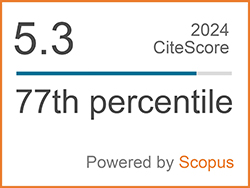Increasing the Efficiency of Gac (Momordica cochinchinensis Spreng) Aril Oil Extraction by Commercial Pectinase Pretreatment and Microwave Dehydration
Abstract
Keywords
[1] A. Abdulqader, A. Ismail, and N. Esa, “Gac (Momordica cochinchinensis Spreng.) fruit and its potentiality and superiority in-health benefits,” Journal of Contemporary Medical Sciences, vol. 4, no. 4, pp. 179–186, Dec. 2018.
[2] H. Aoki, N. T. M. Kieu, N. Kuze, K. Tomisaka, and N. V. Chuyen, “Carotenoid pigments in gac fruit (Momordica cochinchinensis Spreng),” Bioscience. Biotechnology and Biochemistry, vol. 66, no.11, pp. 2479–2482, Nov. 2002.
[3] D. S. Burke, C. R. Smidt, and L. T. Vuong, “Momordica cochinchinensis, Rosa Roxburghii, wolfberry, and sea buckthorn-highly nutritional fruit supported by tradition and science,” Current Topics in Nutraceutical Research, vol. 3, no. 4, pp. 259–266, Nov. 2005.
[4] B. K. Ishida, C. Turner, M. H. Chapman, and A. T. Mckeon, “Fatty acid and composition of Gac (Momordica cochinchinensis Spreng) fruit,” Journal of Agricultural and Food Chemistry, vol. 52, pp. 274–279, Jan. 2004.
[5] L. T. Vuong, A. A. Franke, L. J. Custer, and S. P. Murphy, “Momordica cochinchinensis Spreng. (gac) fruit carotenoids reevaluated,” Journal of Food Composition and Analysis, vol. 19, no. 6–7, pp. 664–668, Sep. 2006.
[6] A. M. Goula and K. G. Adamopoulos, “Stability of lycopene during spray drying of tomato pulp,” LWT - Food Science and Technology, vol. 38, no. 5, pp. 479–487, Aug. 2005.
[7] J. Kubola and S. Siriamornpun, “Phytochemicals and antioxidant activity of different fruit fractions (peel, plup, aril and seed) of Thai gac (Momordica cochinchinensis Spreng),” Food Chemistry, vol. 127, no. 3, pp. 1138–1145, Aug. 2011.
[8] J. Kubola, N. Meeso, and S. Sirimornpun, “Lycopene and beta carotene concentration in aril oil of gac (Momordica cochinchinensis Spreng) as influenced by aril-drying process and solvents extraction,” Food Research International, vol. 50, pp. 664–669, Mar. 2013.
[9] L. T. Vuong, S. R. Dueker, and S. P. Murphy, “Plasma beta-carotene and retinol concentrations of children increase after 30-d supplementation with the fruit Momordica cochinchinensis (gac),” American Journal of Chemical Nutrition, vol. 75, no. 5, pp. 872–829, May 2002.
[10] A. N. Siregar, J. A. Ghani, C. H. Haron, and M. Rizal, “Comparison of oil press for jatropha oil-A review,” Research in Agricultural Engineering, vol. 61, no. 1, pp. 1–13, Mar. 2015.
[11] L. M. Khan and M. A. Hanna, “Expression of oil from oilseeds-A review,” Journal of Agricultural Engineering Research, vol. 28, pp. 495–503, Nov. 1983.
[12] T. C. Kha, M. H. Nguyen, P. D. Roach, and C. E. Stathopoulos, “Effects of Gac aril microwave processing conditions on oil extraction efficiency, and β-carotene and lycopene contents,” Journal of Food Engineering, vol. 117, no. 4, pp. 486– 491, Aug. 2013.
[13] T. C. Kha, H. P. Tai, and M. H. Nguyen, “Effects of pre-treatments on the yield and carotenoid content of Gac oil using supercritical carbon dioxide extraction,” Journal of Food Engineering, vol. 120, pp. 44–49, Jan. 2014.
[14] A. S. Mujumdar, Handbook of Industrial Drying, 4th ed. Boca Raton: CRC Press, 2015.
[15] R. Vadivambal and D. S. Jayas, “Non-uniform temperature distribution during microwave heating of food materials-A review,” Food and Bioprocess Technology, vol. 3, no. 2, pp. 161–171, Apr. 2010.
[16] C. A. M. Berutu, F. Fahrurrozi, and A. Meryandini, “Pectinase production and clarification treatments of apple (Malus Domestica) juice,” Annales Bogorienses, vol. 21, no. 2, pp. 63–68, Feb. 2018.
[17] National centre for biotechnology education, “Pectinase,” 2021. [online]. Available: http:// skpc16.reading.ac.uk/MATERIALS/Enzymes/ pectinex.html
[18] S. Akkarachaneeyakorn, A. Boonrattanakom, P. Pukpin, S. Rattanawaraha, and S. Khantaphant, “Optimization of oil extraction from gac (Momordica cochinchinensis Spreng) aril using a screw press,” Chiang Mai University Journal of Natural Science, vol. 14, no. 3, pp. 257–268, Jan. 2015.
[19] M. Nagata and I. Yamashita, “Simple method for simultaneous determination of chlorophyll and carotenoids in tomato fruit,” Nippon Shokuhin Kogyo Gakkaish, vol. 39, no. 10, pp. 925–928, Oct. 1992.
[20] American Oil Chemists' Society Press (AOCS), Official Methods and Recommended Practices of the AOCS, 5th ed. Champaign: American Oil Chemists' Society, 1997.
[21] D. C. Montgomery, Design and Analysis of Experiments, 10th ed. New York: John Wiley and Sons, 2020.
[22] A. F. Gouvêa, L. O. Ribeiro, E. F. Souza, E. M. Penha, V. M. Matta, and S. P. Freitas, “Effect of enzymatic treatment on the rheological behavior and vitamin C content of Spondias tuberosa (umbu) pulp,” Journal of Food Science and Technology, vol. 54, no. 7, pp. 2176–2180, Jun, 2017.
[23] A. G. J. Voragen, G. J. Coenen, R. P. Verhoef, and H. A. Schols, “Pectin, a versatile polysaccharide present in plant cell walls,” Structural Chemistry, vol. 20, no. 2, pp. 263–275, Apr. 2009.
[24] S. L. Gonzalez, and N. D. Rosso, “Determination of pectin methylesterase activity in commercial pectinases and study of the inactivation kinetics through two potentiometric procedures,” Food Science and Technology, vol. 31, no. 2, pp. 412– 417, Jun. 2011.
[25] H. Silvamany and J. Jahim, “Enhancement of palm oil extraction using cell wall degrading enzyme formulation,” Malaysian Journal of Analytical Sciences, vol. 19, no. 1, pp. 77–87, Feb. 2015.
[26] P. K. Robinson, “Enzymes: Principles and biotechnological applications,” Essays in Biochemistry, vol. 59, pp. 1–41, Nov. 2015.
[27] F. Li, L. Yang, T. Zhao, J. Zhao, Y. Zou, Y. Zou, and X. Wu, “Optimization of enzymatic pretreatment for n-hexane extraction of oil from Silybum marianum seeds using response surface methodology,” Food and Bioproducts Processing, vol. 90, no. 2, pp. 87–94, Apr., 2012.
[28] D. Shankar, Y. C. Agrawal, B. C. Sarkar, and B. P. N. Singh, “Enzymatic hydrolysis in conjunction with conventional pretreatments to soybean for enhanced oil availability and recovery,” Journal of the American Oil Chemists’ Society, vol. 74, no. 12, pp. 1543–1547, Dec. 1997.
[29] S. Pinthong, K. Judprasong, N. Tangsuphoom, S. jittinandana, and Y. Nakngamanong, “Effect of different drying processes on physical properties and carotenoid content of Gac fruit (Momordica cochinchinensis Spreng.),” Journal of Food Science and Agricultural Technology, vol. 5 (Spcial Issue), pp. 61–70, Jan. 2019.
[30] R. Vadivambal and D. S. Jayas, “Non-uniform temperature distribution during microwave heating of food materials-A review,” Food and Bioprocess Technology, vol. 3, no. 2, pp. 161– 171, Aug. 2010.
[31] D. T. T. Nhung, P. N. Bung, N. T. Ha, and T. K. Phong, “Changes in lycopene and beta carotene contents in aril and oil of gac fruit during storage,” Food Chemistry, vol. 121, no. 2, pp. 326–331, Jul. 2010.
[32] R. K. Saini, A. E. D. Bekhit, S. Roohinejad, K. R. R. Rengasamy, and Y. S. Keum, “Chemical stability of lycopene in processed products: A review of the effects of processing methods and modern preservation strategies,” Journal of Agricultural and Food Chemistry, vol. 68, no. 3, pp. 712–726, Dec. 2019.
[33] G. E. Anthon, and D. M. Barrett, “Thermal inactivation of lipoxygenase and hydroperoxytrienoic acid lyase in tomatoes,” Food Chemistry, vol. 81, no. 2, pp. 275–279, May 2003.
[34] T. H. Tran, “Producing carotenoid-rich powder from Gac fruit,” M.S. Thesis, Center for Plant and Food Science, University of Western Sydney, 2007.
DOI: 10.14416/j.asep.2022.02.007
Refbacks
- There are currently no refbacks.
 Applied Science and Engineering Progress
Applied Science and Engineering Progress







